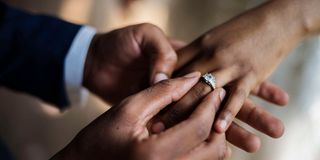Why the wedding ring legacy is a claim to patriarchy

Marriage is a voluntary union of two, with the intention of companionship based on mutual love and respect
What you need to know:
- The wedding ring is believed to have originated in ancient Egypt, diffused to Greece and eventually made its way to European destinations through which it was exported to Africa via colonisation and Christianity.
- The male precedence dynamic is evident in the fact in Christian weddings, the man places the ring on the woman’s hand first and takes the first vow.
It is the one-time Chief Justice of Kenya Cecil Miller (1986–89) who, when asked by a journalist whether he was married, replied that the question should be directed to his wife because in his Guyanese tradition, it is women who are married; men marry. Humorous as the reply was, it captured an important gender dynamic in the practice of marriage. From a linguistic point of view, he meant that men are the subjects of marriage while women are the objects.
This is quite similar to the Luo tradition, where it is said that a man kendo (marries) or nyombo (pays bride wealth, figuratively marries) while a woman ikendo (is married) or dhi tedo (goes to cook, figuratively married). This is consonant with the global social norm that men initiate romantic relationships. Thus, girls are socialised to expect men to do the asking. If a woman does, she is judged as amorous.
A similar gendered norm exists with regard to the wedding ring, worn by both the bride and the groom during celebration of Christian marriages. The male precedence dynamic is evident in the fact in Christian weddings, the man places the ring on the woman’s hand first and takes the first vow. This is basically a prescription of the pecking order in the marriage consonant with patriarchy and the subject-object pattern.
The wedding ring is an exotic nuptial practice Africans have adopted hook, line and sinker but whose patriarchal foundations may not be known to many. This item is believed to have originated in ancient Egypt, diffused to Greece and eventually made its way to Rome and other European destinations through which it was exported to Africa via colonisation and Christianity, with Kenya receiving it from the British. Among Egyptians, wedding rings came in the form of wooden reeds or hemps.
In medieval England, a man interested in marrying a woman gave her an item called the wed, which was often a ring, a form of deposit and basically a promise to marry the woman later. It is much later that the church decreed that men should also wear wedding rings, the sole purpose being to keep them faithful to the wives. This suggests that many men who had placed wedding rings on women continued philandering. Some literature indicates that wearing of the wedding ring by men was popularised during the first world war by American and European (male) soldiers who wore them as sentimental items to remind them of the lovers they left back home. The practice was thereafter adopted by civilians.
A clear gender dynamic arises from this history, that the ring was a means for men to book wives. This resembles a Samburu practice where a male youth places a bead necklace on the targeted lass to secure her sexual services. The necklace symbol deters other prospectors from targeting the beaded girl. There is no equivalent item to tie the man down to the beaded girl. This coheres with the norm of granting men sexual licence while the same is frowned upon if and when practised by women.
This again reminds us of the case of a woman adopting the husband’s name upon marriage. This is actually another Western practice imposed on Africans. By taking on the title ‘Mrs,’ women announce it to the world that their status has changed. The woman subordinates her maiden identity while the man does not have to do the same. Some men actually consider wives who do not change their names as rebels and might even suspect them of infidelity. But is the mere wearing of a ring or change of name a sign of character?
In some liberal churches today, couples are not compelled to exchange rings or take the traditional vows but are given an option to do as they wish in symbolising their unions. Instead of the ring, some would wear wrist bands or other items. And instead of the traditional vow, couples compose their own citations.
In many African marital practices, the equivalents of the wedding ring are animals and other gifts paid as bride wealth to cement a nuptial relationship. Notably, many pastoralist communities in Kenya, such as the Maasai, Samburu and Pokot, bedeck the bride in colourful neck beads, bangles and jewellery to denote the change in status when they get married. Hardly anything is given to men to signify this change.
These marital traditions are so engrained that people hardly question them, yet we should because they embody patriarchal foundations that perpetuate women’s subordination. It is quite apparent in many of them that women are regarded as the moral custodians of marriage while men are free canons. Food for thought.
The writer is a lecturer in Gender and Development Studies at South Eastern Kenya University ([email protected]).





